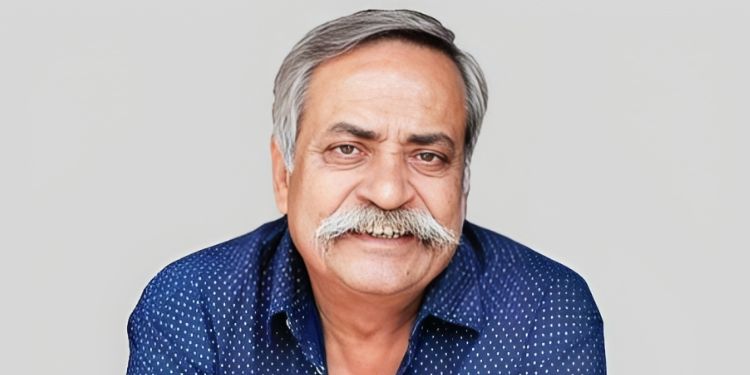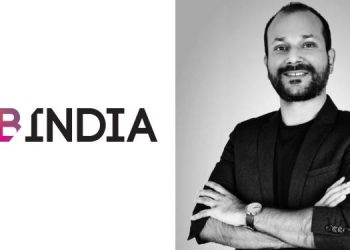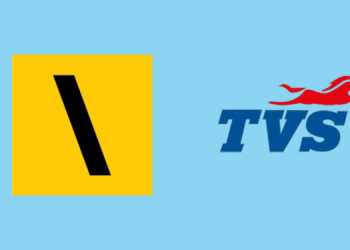Piyush Pandey, Chairman Global Creative and Executive Chairman, Ogilvy India, is not going anywhere. Starting January 2024, he will move into a Chief Advisor role at the agency he has spent 41 years with. Hephzibah Pathak will move up to fill his shoes as Executive Chairperson, while VR Rajesh will transition to be the Chief Executive Officer.
CSO Prem Narayan and CCOs Harshad Rajadhyaksha, Kainaz Karmakar and Sukesh Nayak now join the Ogilvy Board. SN Rane, Group Executive Co-Chairman India and COO, South Asia, will be Business Advisor to Ogilvy APAC. All the talent taking up the leadership roles have come from within the agency.
Pandey will continue to partner key clients. He will work with the executive team including on new business prospects, the creative product and participate in industry bodies and award forums.
Global CEO Devika Bulchandani said, “David Ogilvy said if you want to create a company of immortals, you hire giants. Among the 15,000 people that we have in 93 countries, there is one giant (Piyush Pandey) that is bigger, legendary, and known all over the world.”
He has in turn hired some giants who now take over day to day operations, she added.
“While I have been the face of the agency, it is the team that has done all the work in the last few years,” said Pandey, expressing confidence in the incoming leadership.
“They are ready to rock. It’s time for me to play a bit of coach, player and watcher. It’s time to bring on the players who are in form, stand behind them, and let them play,” he added.
In a freewheeling chat the day after the announcement was made, we caught up with Pandey over a cup of tea. Edited excerpts from the Q&A:
Let us divide your career till now into four phases, or four decades. Tell us about the most impactful things that marked each phase.
The 1980s actually defined my career. And I have to thank Doordarshan for it. The Asian Games took place in 1982 when I joined. India became a television country, when it became accessible to a lot more people. And the language of the medium happened to be Indian, starting with Hindi followed by other regional languages. At the time, a lot of creative people were trained in writing print ads. Initially, with due respect to them, they ignored TV. But that’s where clients were putting in their money because TV was reaching people in their homes. It was reaching housewives who they had never reached, apart from radio. So that mentality of creative people didn’t help them. Very few tried to learn it.
People like Mani Aiyer (MD) and Suresh Mullick (Creative Head) saw me sometimes beat the system by writing copy for my clients, because my creative guys could not write that stuff for Hindustan Lever. Around ’87, they took me out for lunch, and said ‘Why don’t you come over to the creative side, as Copy Chief – Indian Languages?’ I think that must have been the only designation of its kind in the world, ever. It was a little scary for me – I wondered if it was a glorified name for a translator. They put me in the translator’s room and gave me a small partition. I asked them a simple question: ‘Does this mean I can never be the creative director of this company?’ They looked at me, looked at each other, and said, ‘No’. I told them that I’m on.
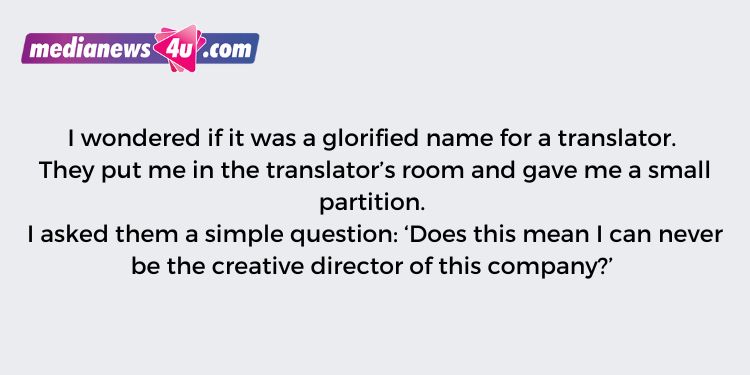
That’s how it began. They got me in as Copy Chief only because it would have been difficult for them to explain to the existing Creative Directors and Associate Creative Directors why this Client Servicing person has come over to the creative side and why he has a designation almost as good as theirs.
Then they asked the creative guys what accounts they would like to give to me. That’s where my lottery happened. Wherever they thought an account was too desi, or it gave them no creative possibilities, they gave them to me. They gave me Luna. They gave me Fevicol. They gave me Asian Paints. I found that they were the most amazing clients. They were ready and hungry for good creative work. I asked one or two of them (my colleagues) what the problems were with these clients. I was told they don’t buy good creative work. I asked them to show me the last good creative work that was presented to them. One of them said, ‘No, we didn’t do it because they don’t buy it.’ I said I don’t buy that. If you had presented some work and that had been rejected, I would understand. But here you didn’t do it because they won’t buy it! To me that was a hypothesis of a weird kind.
I went and presented ‘Dum laga ke aisha’ to Fevicol and they bought it. They gave more work. Kinetic bought ‘Chal meri Luna’. Asian Paints bought some fantastic stuff on festivals. Suddenly, I felt that gods were being kind to me.
I would say in my lifetime, that is the biggest change that has happened. Indian advertising became ‘Indian’.
Today, people are talking about AI and stuff. It has not happened in a big way till now. One of the first people to make it impactfully in the market was us, with the Shah Rukh Khan campaign (for Cadbury). That too worked because the idea was in reaching and helping the small retailers who can’t afford advertising. AI is just the enabler. People didn’t love you because it used AI. They loved you for the wonderful thought.
Tell us about the 90s…
The 1990s saw the opening up. Large multinationals followed a cookie-cutter formula, which largely came from their parent company which told them the way it is done. Half the time they were teaching you how to brush your teeth in three ways, or explaining how dirt comes on to your clothes rather than telling you that if you remove the dirt you’ll look good. That changed hugely in the ’90s. People saw some good advertising and said they also wanted some good stuff. A whole lot of good advertising happened then. We at Ogilvy did some good work and so did others.
Can you cite some of the work from the ’90s?
We did some amazing work on Le Sancy soap (which is no longer around), we did work on Kelvinator, on Onida (without the devil). Asian Paints and Fevicol went into even larger spaces. We did a huge Indian campaign for Dove, whose idea was born in New York but it was done in the most Indian fashion here. We did work for Fevikwik. There were others who did great work as well, as I said, Pepsi did the World Cup work.
The ’90s was about TV advertising getting creative – the transition from entering the homes (in the ’80s) to delighting the homes.
What happened next?
I think the same continued all the way upto 2010 (or so). The ‘boy and dog’ for Hutch happened. Then (in 2009) the Zoozoos happened. A lot of good work was happening, led by Vodafone. We saw unheard of things like making 30 ads for one IPL (Zoozoos) – that was Harit Nagpal and his team. Brands were bursting with creative thinking. We supported it.
Till recently, when people have started to talk a lot about digital, I don’t think I have seen too much of great digital work. I just spoke at Amazon the other day to some of the startups. The day you look at a piece of performance marketing and say, ‘Yes! This delighted me,’ that’s the day performance marketing will make an impact.
When you go to Marine Drive, there are 20 ‘Channa Jor Garam’ stall guys standing in a row. Their product is the same. But you go only to one. Why? The reasons could be any of these: that he always sings a song, that he always keeps agarbathis so that it feels hygienic, that he talks to you very nicely, or that he dresses up his stall attractively. What is all that? Isn’t that branding? His stall may not have a name, but he has created a brand. That is the father of performance marketing. Where 10 things are on a shelf, but one stands out.
No industry should jump onto technology without the idea just because they don’t want to miss the boat. Technology is an enabler of human thinking – to make it faster and so on. But it is not a thinker on its own.
We have seen a lot of gender-sensitive and empowering advertising. There is a Glass Lion at Cannes. Society is also changing. Would you say advertising has played a role in heralding the change?
There are two ways of looking at it. There are a few things that can partly influence society, and partly make your brand more respectable to people. Dove has done it internationally and nationally. They did the ‘Stop the beauty test’. It gets people to think that they are not doing the right thing for their daughter. At a second level, you say that Dove is a good brand because it talks about good things. It is working at both levels.
The same applies to ‘Share the load’ (Ariel). It’s pointing out a human problem that men put every burden on the woman. At the same time it builds respect for the brand because they see it talking about good things.
But, misusing it (purpose) is a stupid mistake. I’ve said this to a very senior person at a very large MNC. When there is a relevant purpose,there is a relevant purpose. You can’t put purpose into everything. I can’t try and sell you a lollipop and try and find a way to put purpose into it. Be sensible about what purpose can be meaningfully associated with your brand, and what purpose will make the consumer say, ‘Hello, do you think I am a fool?’
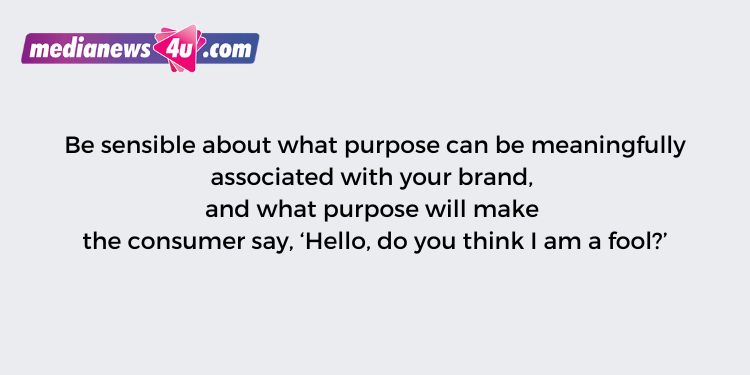
You are credited with grooming the next generation of leaders at Ogilvy and you have said that they are behind most of the good work we have seen in the last few years. Across advertising, there is the view that attracting and retaining talent is more difficult, especially in creative, with other options like films and OTT…
True. I don’t blame the youngsters because the options are so many for them. What I tell them is, switch if you want to – but whatever you are doing right now, give it a fair chance. You don’t want to come back to the same industry three years later and say, ‘Yaar, this was a good place to be.’ Then you’ll be left behind. So I tell them not to try 10 things at the same time. You want to try two, go ahead and try those two things.
The second thing is, we need to give recognition to younger people. Like in the case of Sukesh (Nayak) and his team that did the AI stuff on Cadbury, they gave good recognition to the team. Gone are the days when only the captain was the hero. Youngsters are ambitious, they want recognition, and if they deserve it you must give it. I have always believed that you shouldn’t give credit where it doesn’t belong – otherwise we will be making monsters out of kids. But you should definitely give it when s/he deserves it – because otherwise, we will be making monsters out of kids again.
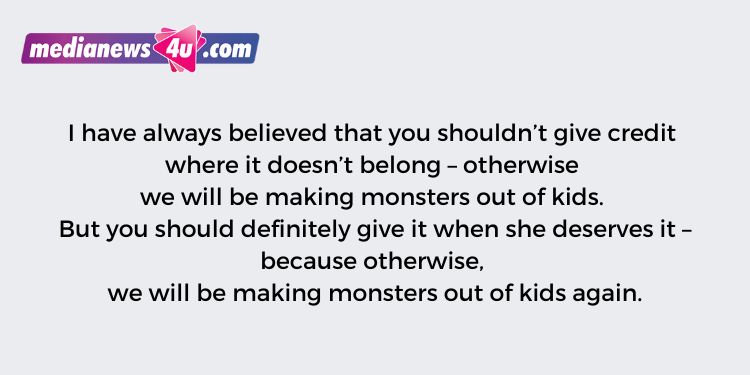 There is a lot of talent. They are much more exposed than we were in our days. We need to explain to them that their talent can attract them to different places, but there is one lifetime.
There is a lot of talent. They are much more exposed than we were in our days. We need to explain to them that their talent can attract them to different places, but there is one lifetime.
You served as Global Chief Creative of Ogilvy for two and a half years. Tell us about that role.
It was fantastic but it wasn’t new to me. I was sitting with them (on the Global Creative Council) for many years. People ask how do you handle a global job? I tell them that we don’t do very much. How can I tell a guy from Vietnam what is good advertising in Vietnam? I don’t even know the language, I don’t even know the culture. And similarly for many such countries. It doesn’t just hold for me, it applies to anyone who is doing this job. Your job is to get together and exchange ideas, and show your belief and faith in the team.
How do you do a PM’s job? A PM doesn’t know a state inside out or the language of the state. But he knows what is good for the state. He will get somebody who can speak in the language of that state. Get that person to explain the problems to him.
A related question. While Ogilvy India has performed at international awards and contributed in good measure to the agency’s global standing, would you agree that there is a far greater body of work that has worked in the Indian market, than has been recognised on the global stage?
This is something I have thought out very clearly and told my teammates. There are two kinds of work. One is the work that delight the people on the streets and sell your product to everybody in this country. Another will delight only international juries and make no difference to your own market. The best work is the one that delights the people on the streets and gets recognised by the juries. We should try and do more of that. But, it is okay to lose an award – don’t lose the guy on the street because that’s what pays your salary.
A great example is Fevicol. Every Tom, Dick and Harry in this country loves it. And every jury member, wherever I go, is looking forward to the next Fevicol work. We didn’t make it for the juries, but it works in both cases. I wish we could do more of that.
On a positive note, if you take the last 10 to 15 years, more of India’s work – not just Ogilvy’s – has travelled. This wasn’t the case in the ’90s.
Work that only works for juries seems to be the one that wins big internationally…
Yes, there is work that wins internationally that some people in the local market won’t even understand. But there is also real work that wins big – Cadbury won big.
It doesn’t matter if there is work that only works for juries that wins. If you have an opportunity and have a client to back it, do it. But I don’t think you can score a 100 by playing all reverse sweeps. If there is a ball to hit the reverse sweep, hit it. And you get the licence to play a reverse sweep only when you’re batting on 75.
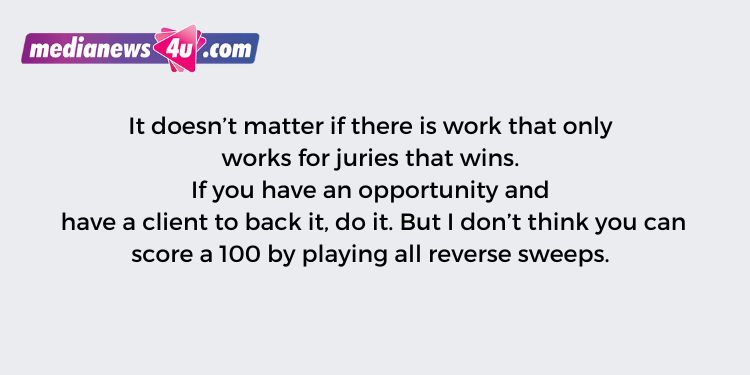
We met in 2014 the day you came back from Delhi after the Lok Sabha election campaign, and results were out. Would it be fair to say that was a different high?
Two big things happened in my career in 2014. Number one was a campaign that I had worked on with passion that led to a result – India was declared polio-free in 2014. That was after many, many years of solid work with Mr. Bachchan, the Ministry of Health and UNICEF. It reached a point that we could celebrate. It was the biggest joy I got out of this skill that I had been able to acquire from my experience. It was much bigger than breaking the market share record for a product.
2014 was the first political campaign I had ever done in my life. And… we did justice to it. No election is won on advertising, it is won on the ground by the karya kartas. You are at best an air cover. And I think we did the job to the satisfaction of the client – and to India which still talks about those lines. Our job was to hold catches and we held the catches.
We had no idea of how a political client would behave with us, whether they would give us an opportunity to do something different. But I had a fantastic experience working with them. They defined the problem very well, defined the opportunity very simply and they allowed us to play.
In 2014, at almost 60, I was still learning new things. I started using WhatsApp. I still couldn’t do long WhatsApps texts. I used to text saying, ‘Call me now’ (laughs).
It was great learning. Things were changing in an instant. Some development happened somewhere, and we had to change the work and create stuff overnight. Kunal (Jeswani) and I stayed at the Ambassador hotel for many months.
What is it that you would like to tell the industry? What are the burning issues that need attention?
The first and foremost thing, to me, is that the audience comes first, the client next and the brand third. Satisfying a client is not my objective. The objective is to satisfy who the client is trying to sell to. A lot has changed from the ’90s, but there are still people you encounter where you feel that they don’t really understand the pulse of the audience. There are clients who say, ‘Tell them about that feature of mine.’ That feature of yours is your big dream in your factory. The person who is going to buy the product doesn’t care. The person cares about how the feature impacts their life.
The next burning issue is one that’s been with me always. If you have an aunt living in Lucknow, take a train and spend 10 days with her. If you haven’t travelled in a train for 48 hours at one go… you will not understand India unless you make that effort to see India. You will not see all of India in a lifetime. But if you see one village, you will understand three States of India. If you go to Gujarat and Rajasthan, 100 kilometres on either side, they eat the same food. The language has so many overlapping words. David Ogilvy said a long time back that if you sit in the ivory towers of New York, you will never know who you are advertising to.
Also, the client is there to make money; they are not stupid. They may not know certain things about your way of doing business, in which case you should hold their hand. It’s so easy to say that the client is stupid for not buying your work. The client wants to buy work. Can you help them understand the work, and how it will impact the business?
Many senior folks talk about the ‘Good old days’ of advertising. Your thoughts.
If you are stuck in the old days, then it’s a problem. ‘Good old days’ that you learn from, are ‘good’ old days.
I learnt very early because of exposure and my exposure was because of circumstances – of a middle class family, and of playing a lot of cricket which made me travel. But those good old days taught me to respect people. People who were not the same as you. Sometimes they were more well-to-do than you, sometimes not, sometimes the same as you. You learn to respect the differences, you learn to respect the circumstances.
I think that’s a better way to look at ‘Good old days’. To say that things used to be so good and now they are absolutely s******… that’s ‘bad’ old days talk.
Anything else you want to share…
There is one thing I want to share, largely with the younger people. The hurry to make money (early) is something they should watch out for because everything gets equalised in four years.
Advertising is a lot more fun than you think. It may not pay you big time in the beginning. It does not, actually. But you will get paid the moment you are settled. And you will be paid right from the beginning, by the joy that you get.
Also Read:
Our journey with the unseen mentor
Unspoken mentorship, profound impact
(First published by The Free Press Journal BrandSutra. Content powered by MediaNews4u.com. Feedback: [email protected])

